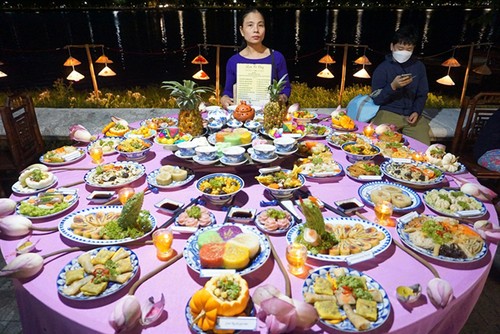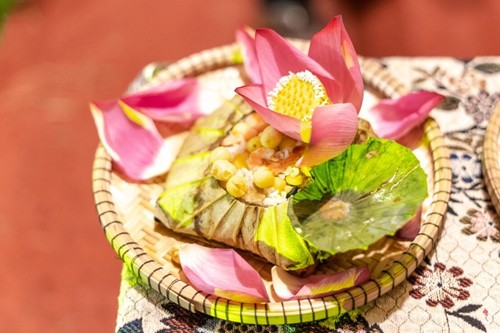 Hue's typical vegetarian dishes (Photo: baovanhoa.vn) Hue's typical vegetarian dishes (Photo: baovanhoa.vn) |
In the strategy to preserve and develop Hue’s culinary heritage, becoming a UNESCO Creative City, a Vietnamese Culinary Capital, and a UNESCO Heritage are the three main goals to promote Hue’s potential and strengths.
It will strengthen Hue’s position as a large and unique cultural center of Vietnam, affirm Hue’s cuisine in the world, and make the culture of Hue and Vietnam prosper.
Among the 3,000 Vietnamese dishes inscribed by the Nguyen dynasty, Hue is associated with 1,700 of them. Cooking has always been considered a principal cultural feature of Hue.
Over the years, Hue has encouraged culinary creativity to create unique products, generate jobs, and increase people’s incomes. This accords with UNESCO’s requirements for cities to join its network.
 Steamed rice with lotus seeds is a specialty of Hue. (Photo: Bao Minh/ bvhttdl.gov.vn) Steamed rice with lotus seeds is a specialty of Hue. (Photo: Bao Minh/ bvhttdl.gov.vn) |
At a symposium on UNESCO’s Creative Cities Network in Hue city last Friday, Phan Ngoc Tho, Deputy Secretary of the provincial Party Committee, said the criteria of the culinary dossier are Hue’s strengths: being the culinary capital of Vietnam and a highlight of Southeast Asian cuisine, a broad range of dishes from royal delicacies to common fare, and the blending of cuisine with folk art and traditional costumes like the ao dai.
Thue Thien-Hue province has a roadmap for joining the Creative Cities Network by 2025 or 2027.
Ho Thang, Director of the provincial Department of Science and Technology, says it’s necessary to build trademarks for traditional culinary products and use the intellectual property system as a tool for competition and brand development.
The UNESCO Creative Cities Network was initiated in 2004 to promote cooperation among cities and make creativity a strategic factor for sustainable city development.